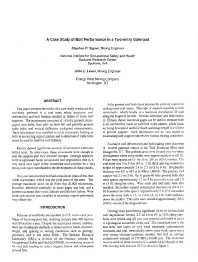Mining Publication: A Case Study of Bolt Performance in a Two-entry Gate Road
Original creation date: August 1998
This paper presents the results of a case study conducted in a two-entry gateroad in a coal mine where excessive roof deformation and bolt loading resulted in failure of many roof supports. The instruments consisted of 16 fully grouted, strain-gaged resin bolts, load cells on both full and partially grouted cable bolts, and vertical deflection multipoint extensometers. These instruments were installed on-cycle to measure loading on bolts in an existing support pattern and to determine if cable bolts could be used to improve roof stability. Results showed significant amounts of movement within the bolted zone. In some cases, these movements were enough to load the supports past their ultimate strength. Geology appeared to be a significant factor in localized roof degradation; that is, a very weak rock layer in the immediate roof overlain by a very strong rock layer contributed to the development of shear planes. Only one instrumented bolt had a maximum strain of less than 2,000 microstrain, which was the yield point of the steel. The average maximum strain on all bolts was 20,000 microstrain. However, electrical continuity to many gages was lost, and a pattern was noted that would indicate possible bolt failure. Wire mesh and concrete cans installed as secondary support performed very effectively.
Authors: SP Signer, JL Lewis
Conference Paper - August 1998
17th Conference on Ground Control in Mining, West Virginia University, August, 1998; :249-256
See Also
- Determination of Physical Properties of Cable Bolts in Cement Grout Pull Tests Using Instrumented King Wires
- Diagnosing and Controlling Moisture-Sensitive Roof in Coal Mines
- Optimizing Secondary Roof Support with the NIOSH Support Technology Optimization Program (STOP)
- Overview of Coal Mine Ground Control Issues in the Illinois Basin
- Pillar and Roof Span Design Guidelines for Underground Stone Mines
- STOP - Support Technology Optimization Program - 3.4
- Technology News 476 - Instrumented King Wire for Monitoring Cable Bolts
- Technology News 482 - Ground Support Safety Training Video
- Tests of Fibre-Reinforced Shotcrete at the Chief Joseph Mine, Butte, Montana
- Updating the NIOSH Support Technology Optimization Program (STOP) With New Support Technologies and Additional Design Features
- Page last reviewed: 9/21/2012
- Page last updated: 9/21/2012
- Content source: National Institute for Occupational Safety and Health, Mining Program


 ShareCompartir
ShareCompartir
